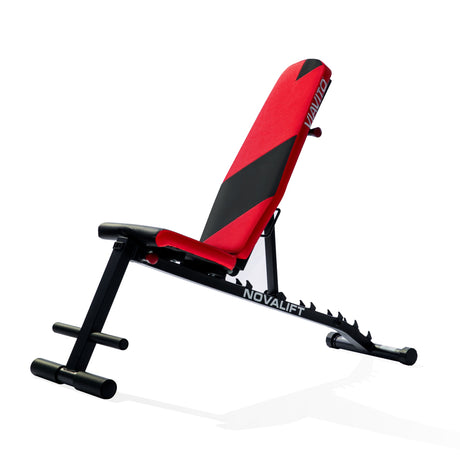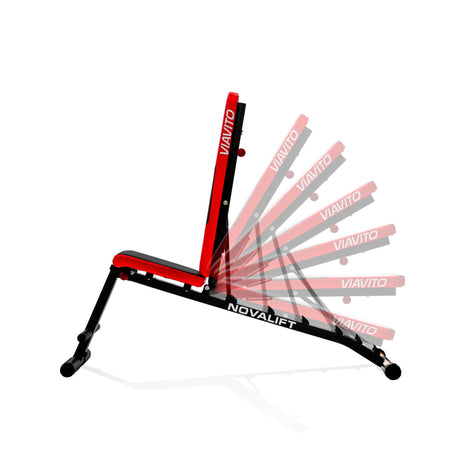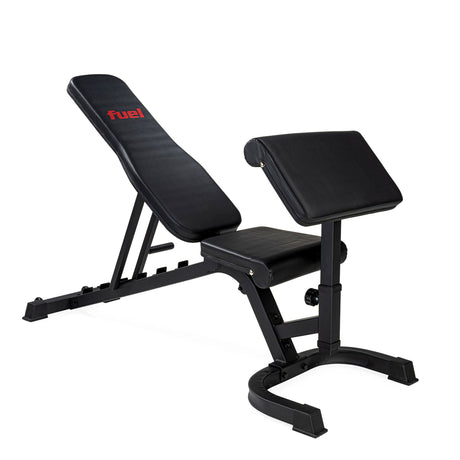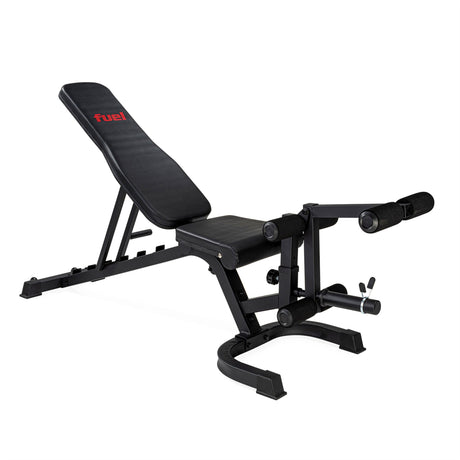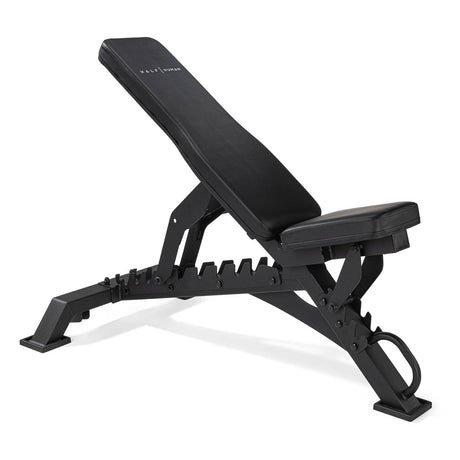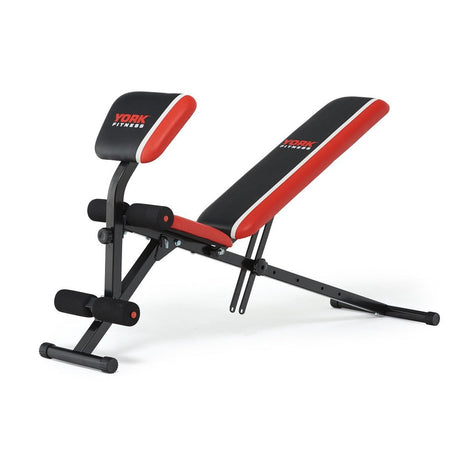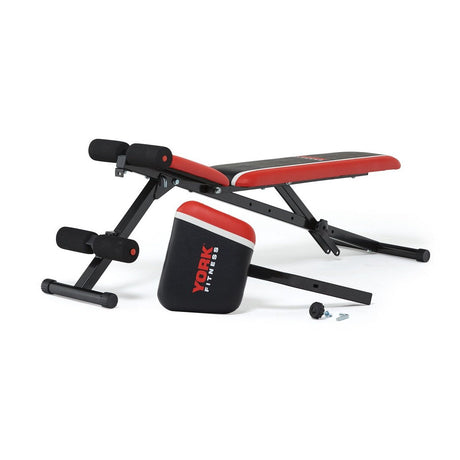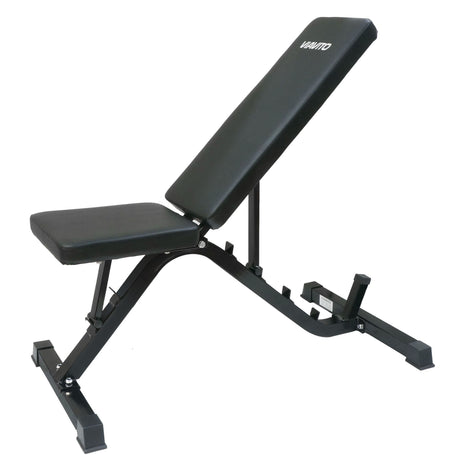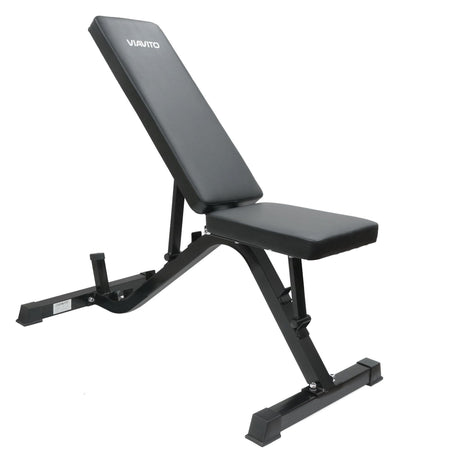Utility Benches / Dumbbell Benches / Adjustable Benches
These are the names commonly given to a bench with no upright barbell supports and some degree of adjustability. Having no vertical supports may render the bench as impractical/unsafe for the purposes of barbell presses but it does make them ideally suited for a plethora of dumbbell exercises needing freedom of movement without obstruction.
Maximum Weight Capacities
Whether you are looking for a utility bench or a barbell bench – ALL have a maximum rating of how much weight can safely be supported. Some manufacturers clearly set out a helpful breakdown of the maximum capacities of key weight-bearing parts, so it’s all rather self-explanatory (Maximum user weight…maximum weight that can be supported on the upright rack…leg developer weight capacity etc). Unfortunately, many products only come with an overall maximum weight capacity, which is a little vaguer. In this instance, you must include your own bodyweight PLUS the additional weight of either the dumbbells or the barbell and weight plates, to give you a total, which must be under the maximum rated figure for safety.
Backrest Adjustability
The adjustability of the seat is an important consideration, as the angle of the body will determine what portion of muscles will be targeted. In simplified terms, think of a decline angle working the lower portion of the pectoral muscle (chest) and the higher the angle is inclined, the higher up the chest you’ll be working (so a 45-degree angle will be working the upper chest region). When the angle exceeds about 60 degrees then the muscles of the shoulder will take over.
The greater range of adjustability the wider the scope for exercise variation. Not all benches offer a range of adjustability that allows for decline presses (for the lower chest) or upright back support for overhead presses (for the shoulders). These are undoubtedly great exercises in a weightlifters’ arsenal, but if you opt for a bench that doesn’t have these features it may not necessarily be a deal-breaker e.g. If the backrest doesn’t angle up to about 85 degrees then you can perhaps perform overhead presses by simply sitting on the flat bench N.B. without back support, extra care should be taken to ensure your back is not strained (As always – ONLY ever do what is safe and sensible!)
Some benches feature adjustable seats so that when the backrest is inclined the seat can also angle up to prevent the user from sliding downwards as well as encouraging the lower back to remain flat.
Barbell Benches
The very first barbell benches were designed around one of the most popular and effective exercises ever devised - the ‘Bench Press’. Renowned for packing muscle onto the upper body, it’s usually the cornerstone of any self-respecting weight trainer’s routine. Not surprisingly, without a Bench, you have no Bench Press! - But without the right bench, you could also be missing out on a whole lot more. In recent years, Barbell Benches have evolved, with design features to cover a wide range of exercises, from the legs right up to the shoulders! Here’s what to look out for when choosing the right barbell bench for your needs…
Olympic or Standard?
The terms ‘standard’ or ‘Olympic refers to the diameter of the hole in the centre of the weight plate. Standard plates have a 1” diameter hole in the centre of the discs to accept 1” wide bars whereas ‘Olympic weight plates have a 2” diameter hole. For obvious reasons, a standard bar can hold both types of weight plates (although the Olympic discs will feel a little loose); Whereas Olympic bars are too wide to accept standard plates. Fortunately, many benches have standard bar fitments to accept both styles of discs, or they may often have removable Olympic sleeves which can be slid off to reveal 1” thick bars for use with standard plates (just make certain any Olympic features are removable before you buy if you only have access to standard discs!)
Bar Length Capacities
Barbell benches are mainly designed with a fixed width between the upright barbell supports. The width between them determines what length of barbell is most suitable. Bars are typically available at 5’, 6’ and 7’ lengths but the importance of the correct hand positioning for safe pressing movements, means that it’s not a ‘one size fits’ all. A 5’ barbell will not be ideally compatible with wider ‘olympic style’ racks which are generally built around a 7ft bar (as used in commercial environments). Also, a 5 ft bar may also feel too narrow for some users (especially with long arms) as the forearms and elbows can feel too close to the weight plates when the arms are bent in the bottom position. Alternatively, a 7’ bar may feel very unstable and prone to tip up on a narrow, entry-level barbell bench.
The golden rule is to double-check what bar lengths are compatible with each bench before you buy.
Spotter Catches
‘Spotter catches’ refers to the bar holders at the top of each upright that support the barbell. Often they are adjustable so as to be positioned at various heights. This type of adjustability is an important feature to look out for, to ensure you can position yourself at a safe distance within easy reach to comfortably lift off and replace the bar.
During a workout, muscles can fatigue without much warning, so it’s critical that exercises like Bench press or overhead presses should never be performed without a training partner (‘spotter’) on standby, to assist or supervise every lift. For further peace of mind, some benches also feature a second pair of Safety spotter catches on each upright to act as a type of ‘safety net’! Being adjustable they should be positioned on (or fractionally lower) than the level the bar will be when at the bottom position. If you’re unable to push the bar all the way back up to the top catches, the weight can be safely set down onto the lower safety ‘spotter’ catches.
Leg Developer
This simple attachment can literally make all the difference, by granting a total body workout and thus a more balanced, well-proportioned physique! The lower set of roller pads can be utilized for ‘leg extensions’ to target the quadriceps at the front of the thighs. Alternatively, by lying down on the bench and positioning the top rollers over the backs of the lower legs, the weight can be lifted in a ‘leg curl’ exercise to develop the often-neglected hamstring muscles.
Bicep Preacher Curl Pad
A popular feature on some barbell and utility benches is a preacher pad. This is an angled pad at the foot of the bench which supports the backs of the upper arms so that strict ‘preacher’ curls can be performed to isolate the bicep muscles.
Other Attachments
Although far less common than leg developers or preacher pads, some benches feature attachments for chest flyes and even a lat pulldown attachment for back exercises.
Detachable Benches
A stand-alone bench and rack combination also offers plenty of scope for exercise variations. For starters, when you detach the bench away from the rack, it instantly becomes a utility bench. In addition, by removing the bench you then have clear access to the upright supports which can then be used as a rack for squats and much, much more!






